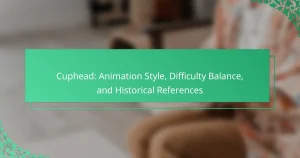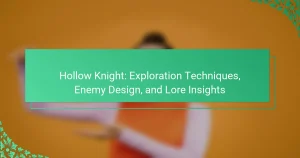Shovel Knight captivates players with its engaging gameplay mechanics, compelling storyline, and distinctive art style. Explore core mechanics like platforming and treasure collection, delve into the knight’s quest to rescue Shield Knight, and appreciate the retro-inspired art that enhances the game’s charm. Discover how these elements work together to create an immersive experience for players.
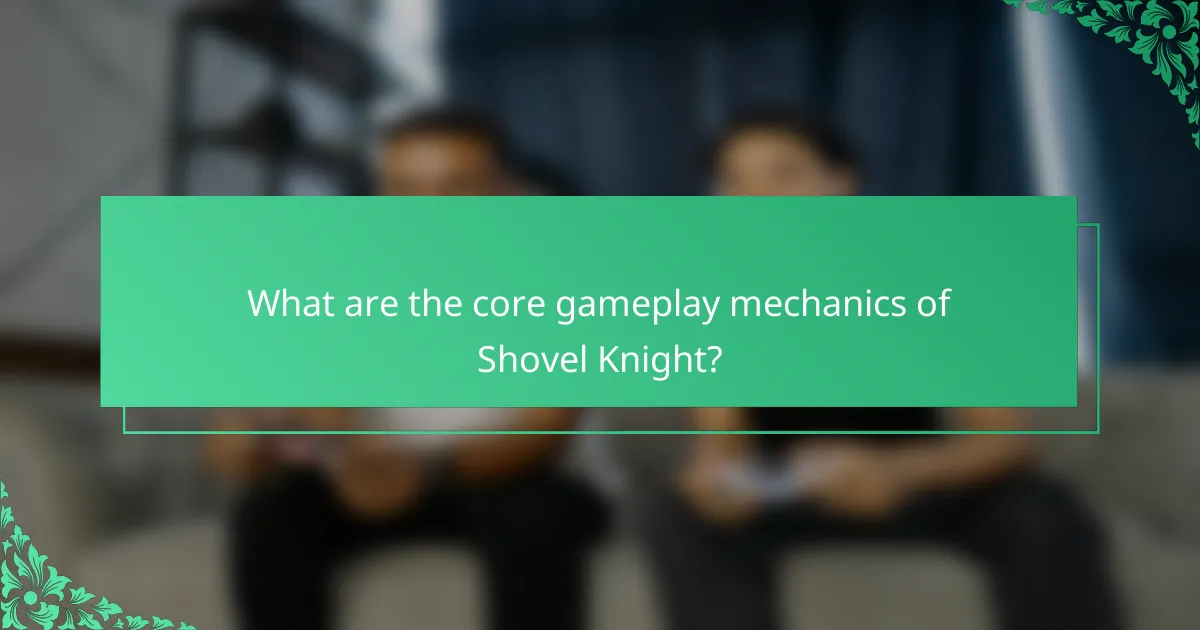
What are the core gameplay mechanics of Shovel Knight?
Shovel Knight features core gameplay mechanics that include platforming, combat, and treasure collection. Players navigate levels filled with enemies and obstacles, utilizing a shovel for digging and attacking. The game emphasizes exploration, rewarding players with upgrades and new abilities. Unique mechanics like the ability to bounce off enemies enhance gameplay depth.
How do combat mechanics enhance player experience?
Combat mechanics in Shovel Knight significantly enhance player experience by providing engaging challenges and rewarding interactions. The game’s mechanics, such as the shovel-based attacks and enemy patterns, create a dynamic combat system that encourages strategic thinking. Players must learn enemy behaviors, adapt their tactics, and utilize power-ups effectively to progress. This depth fosters a sense of accomplishment and mastery as players overcome obstacles. Unique attributes, like the ability to bounce off enemies using the shovel, add a layer of creativity to combat, making each encounter feel fresh and exciting.
What role does exploration play in gameplay?
Exploration is crucial in Shovel Knight as it enhances gameplay by encouraging player engagement and discovery. Players uncover hidden areas, collect treasures, and encounter unique enemies, which enriches the overall experience. The game’s design rewards exploration with power-ups and narrative elements that deepen the storyline. Players often find secrets that provide advantages, showcasing the unique attribute of Shovel Knight’s level design that intertwines exploration with gameplay mechanics.
Which power-ups and abilities are essential for progression?
Essential power-ups and abilities for progression in Shovel Knight include the Relics, which provide unique combat enhancements. Key Relics like the Chaos Sphere and the War Horn significantly aid in battles. The ability to upgrade armor impacts defense and mobility. Additionally, collecting gems enhances purchasing power for upgrades and health restoration. Mastering these mechanics is crucial for navigating challenging levels and defeating bosses effectively.
How does level design influence gameplay flow?
Level design significantly influences gameplay flow by controlling player movement and interactions. In “Shovel Knight,” the intricate level layouts guide players through challenges while maintaining engagement. This design fosters a balance between exploration and combat, enhancing the overall experience. Unique attributes like hidden areas and environmental hazards create memorable moments, while root attributes such as platforming mechanics ensure fluidity in gameplay. The combination of these elements leads to a cohesive and enjoyable gaming journey.
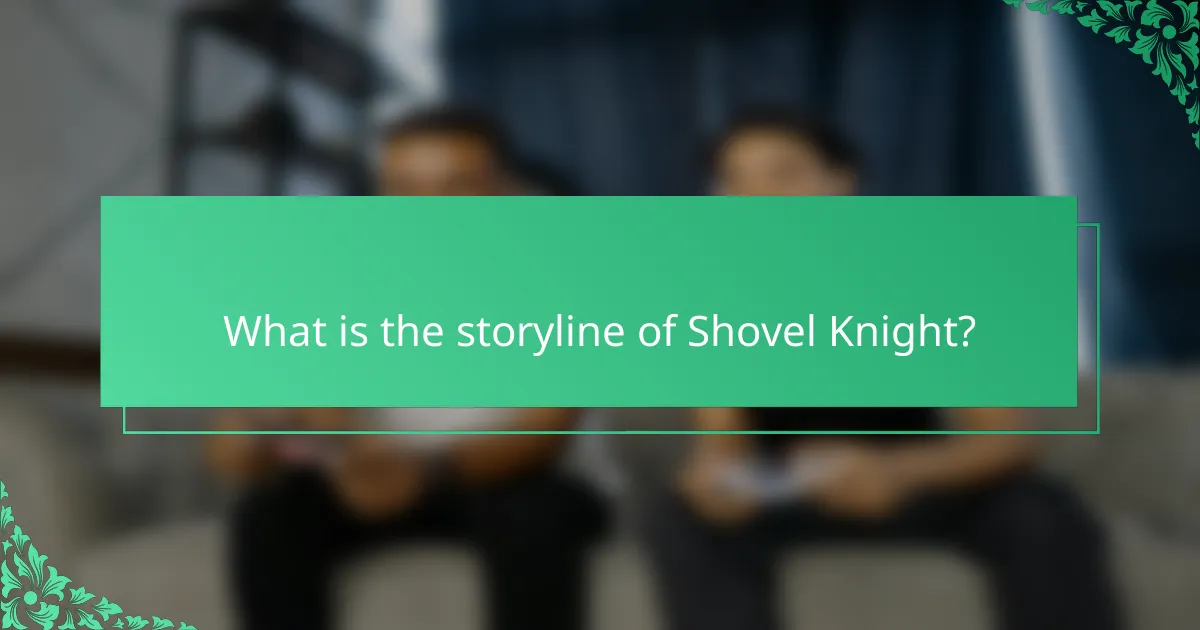
What is the storyline of Shovel Knight?
Shovel Knight follows the journey of the titular knight as he embarks on a quest to rescue his partner, Shield Knight, from the evil Enchantress. The storyline unfolds through various levels, each guarded by a formidable knight, as Shovel Knight battles foes and uncovers the Enchantress’s dark plans. Along the way, themes of redemption, friendship, and heroism are explored, culminating in a climactic confrontation that tests Shovel Knight’s resolve and strength. The narrative is enriched by character interactions and the knight’s personal growth throughout the adventure.
How do character arcs develop throughout the game?
Character arcs in Shovel Knight develop through player choices and narrative progression. Each knight embodies distinct motivations and conflicts, influencing their evolution. For instance, Shovel Knight transitions from a vengeful hero to a protector, highlighting themes of redemption. The interactions with other characters, such as Shield Knight, deepen emotional stakes and propel growth. As players advance, they witness transformations that reflect personal and thematic journeys, enhancing engagement and storytelling depth.
What themes are explored in the narrative?
Shovel Knight explores themes of heroism, nostalgia, and redemption. The narrative emphasizes the struggle between good and evil, showcasing the protagonist’s journey against various foes. Additionally, it reflects on the importance of friendship and loyalty through character interactions. The game’s art style enhances these themes, evoking a sense of classic gaming while delivering a modern twist.
Which key events shape the plot?
Key events that shape the plot of Shovel Knight include the protagonist’s quest for revenge against the Order of No Quarter, the rescue of Shield Knight, and the final confrontation with the Enchantress. Each event drives character development and gameplay progression. The interactions with various knights and the evolving narrative create a rich tapestry that enhances the player’s experience. The unique attribute of Shovel Knight is its blend of retro aesthetics with modern gameplay mechanics, which adds depth to the storyline.
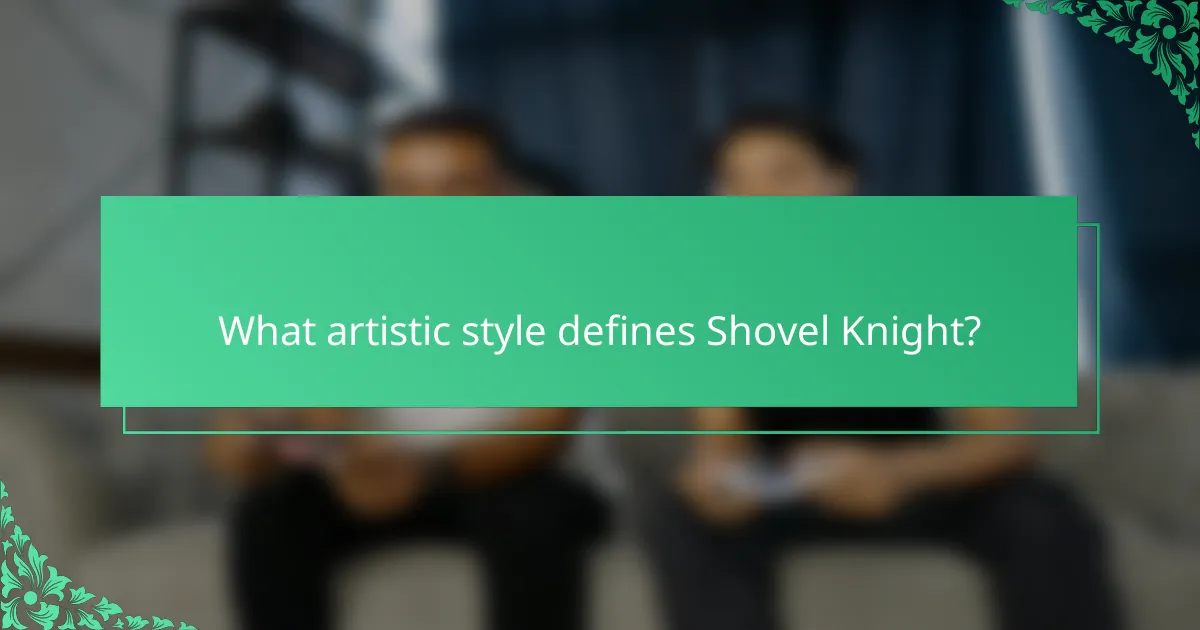
What artistic style defines Shovel Knight?
The artistic style that defines Shovel Knight is a blend of retro 8-bit aesthetics and modern design principles. This visual approach pays homage to classic platformers while incorporating detailed animations and vibrant color palettes. The pixel art style enhances the nostalgic feel, creating an engaging atmosphere that resonates with players. Unique attributes include character designs inspired by various knightly archetypes, adding depth to the game’s lore and visual appeal. The art style significantly contributes to the overall charm and identity of Shovel Knight.
How does pixel art contribute to the game’s aesthetic?
Pixel art significantly enhances Shovel Knight’s aesthetic by creating a nostalgic visual experience. This art style evokes memories of classic 8-bit games, reinforcing the game’s retro theme. The limited color palette contributes to a distinct and recognizable character design, making each character and environment memorable. Additionally, pixel art allows for detailed animations within a constrained framework, showcasing the game’s dynamic action while maintaining its charming simplicity. Overall, pixel art is integral to Shovel Knight’s identity, blending gameplay and visual storytelling seamlessly.
What color palettes are used to evoke emotions?
Shovel Knight uses a vibrant color palette to evoke nostalgia and excitement. The game employs primary colors to create a cheerful atmosphere, while darker shades enhance tension during challenging gameplay. Bright colors signify joy and adventure, while muted tones convey danger and mystery. This strategic use of color deepens emotional engagement and reinforces the storyline.
How does the art style pay homage to retro gaming?
The art style of Shovel Knight pays homage to retro gaming through its pixel art, 8-bit color palette, and nostalgic character designs. This aesthetic evokes classic platformers from the 1980s and 1990s, enhancing the gameplay experience. The use of chiptune music further reinforces this connection, creating an immersive atmosphere reminiscent of early gaming. Additionally, the game incorporates modern design elements while maintaining a retro feel, appealing to both nostalgic players and new audiences.
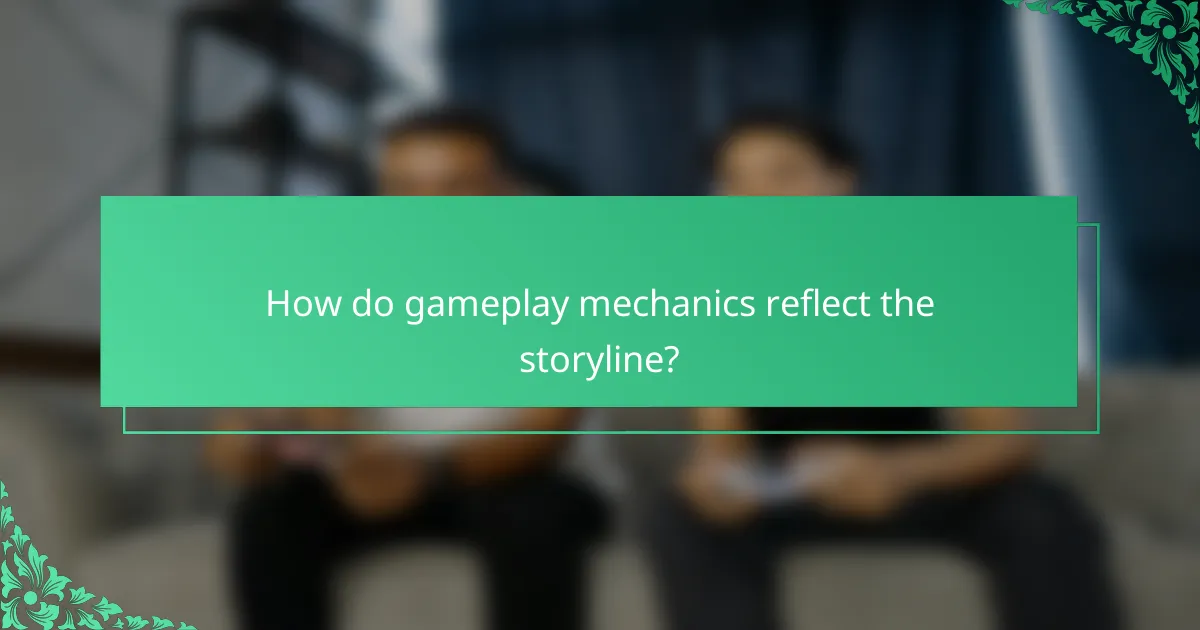
How do gameplay mechanics reflect the storyline?
Gameplay mechanics in Shovel Knight enhance the storyline by integrating character abilities and level design. The protagonist’s shovel allows for unique interactions with the environment, reflecting themes of exploration and adventure. Each mechanic, such as digging or bouncing off enemies, aligns with the narrative of overcoming challenges. The art style further complements this by visually representing the game’s whimsical yet perilous world, reinforcing the connection between mechanics and story. This synergy creates an immersive experience, where gameplay not only serves as entertainment but also deepens the player’s engagement with the narrative.
What connections exist between character abilities and narrative elements?
Character abilities in Shovel Knight enhance narrative elements by deepening player engagement and advancing plot progression. Abilities like the Shovel Drop not only serve gameplay mechanics but also symbolize the protagonist’s growth. The storyline intertwines with these abilities, as each power reflects Shovel Knight’s journey against various foes. Unique attributes of character abilities, such as the ability to bounce off enemies, create dynamic interactions that enrich the narrative experience. Rare abilities, like the use of relics, further emphasize themes of exploration and discovery within the game world.
How does player choice impact the unfolding of the story?
Player choice significantly influences the storyline in Shovel Knight, allowing for varied outcomes and character interactions. The game features multiple paths and decisions that shape the narrative experience. For instance, players can choose to confront different bosses in varying orders, affecting the story’s progression and character development. This mechanic enhances replayability and personal investment in the story. Additionally, choices can lead to unique dialogue options and alternate endings, showcasing how player agency directly impacts the unfolding narrative.
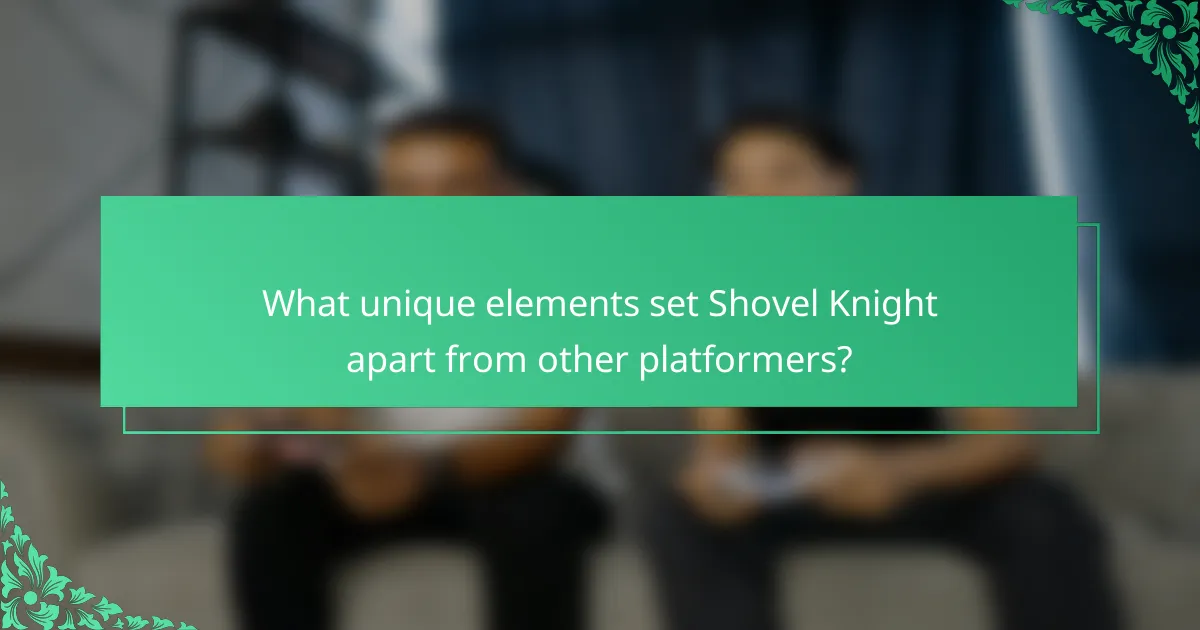
What unique elements set Shovel Knight apart from other platformers?
Shovel Knight stands out from other platformers due to its unique blend of retro-inspired gameplay, engaging storyline, and distinctive art style. Its gameplay mechanics incorporate elements like customizable abilities and a robust combat system, enhancing player engagement. The storyline features a hero’s journey with emotional depth, exploring themes of love and redemption. The art style is characterized by pixel art graphics that evoke nostalgia while delivering modern aesthetics. This combination creates a rich experience that resonates with both new and veteran gamers.
Which innovative features are exclusive to Shovel Knight?
Shovel Knight features unique mechanics like the customizable relic system and the ability to bounce off enemies. These innovations enhance gameplay strategy and provide varied combat options. The game also includes an exclusive cooperative multiplayer mode, allowing players to team up as different knights, increasing engagement.
How does the game balance nostalgia with modern design?
Shovel Knight balances nostalgia with modern design by integrating classic gameplay mechanics while enhancing visuals and controls. The game features pixel art that evokes retro aesthetics, yet incorporates fluid animations and responsive controls. This blend creates a familiar yet fresh experience, attracting both veteran players and newcomers. Additionally, the storyline pays homage to classic platformers, with a modern twist in character development and humor, enriching player engagement.
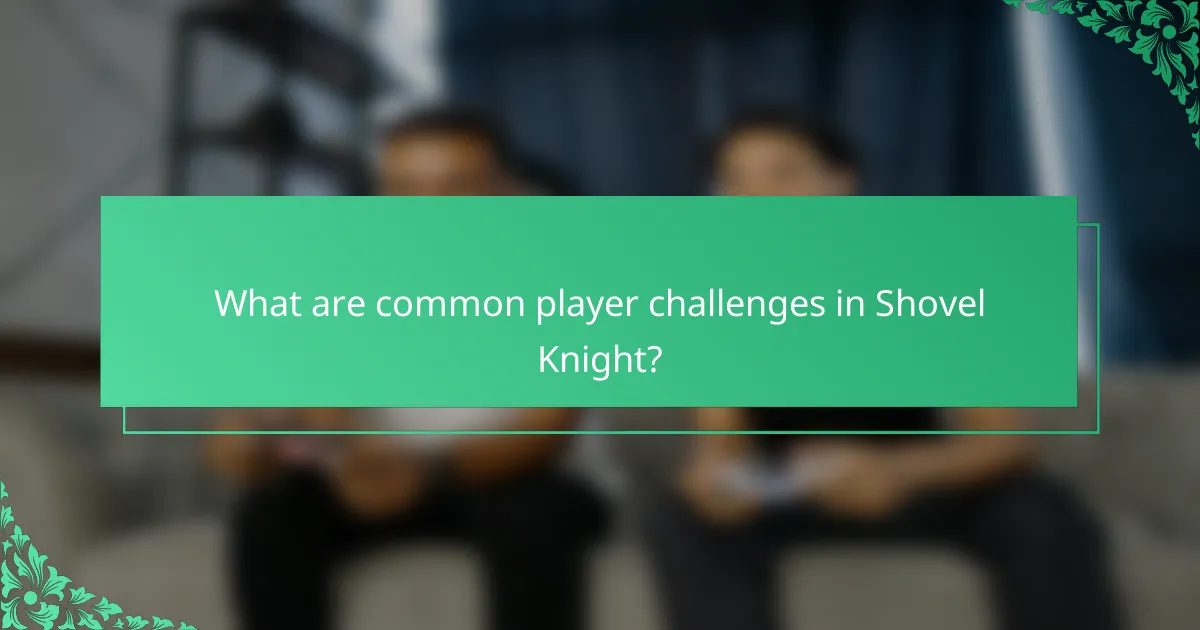
What are common player challenges in Shovel Knight?
Players in Shovel Knight face several challenges, including difficult platforming sections, enemy encounters, and resource management. Navigating treacherous terrain requires precise jumps and timing. Boss fights demand strategic thinking and adaptability. Additionally, collecting gold while avoiding hazards adds to the game’s complexity. These elements combine to create a rewarding yet challenging gameplay experience.
How do difficulty levels affect player engagement?
Difficulty levels in Shovel Knight significantly impact player engagement by balancing challenge and reward. Higher difficulty levels can enhance satisfaction through mastery, while lower levels may attract casual players seeking enjoyment. The game’s design encourages exploration and skill development, making the difficulty progression integral to the overall experience. As a result, players often feel motivated to improve, leading to increased replayability and deeper immersion in the storyline and mechanics.
What strategies can players employ to overcome obstacles?
Players can overcome obstacles in Shovel Knight by mastering timing, utilizing power-ups, and exploring the environment. Effective timing is crucial for dodging enemy attacks and navigating platforming challenges. Power-ups, such as health-restoring items, can provide necessary advantages during tough encounters. Exploration reveals secrets and upgrades that enhance abilities, making it easier to tackle difficult sections. Additionally, players should learn enemy patterns to anticipate attacks and counter effectively. These strategies collectively improve gameplay and facilitate progress through challenging levels.
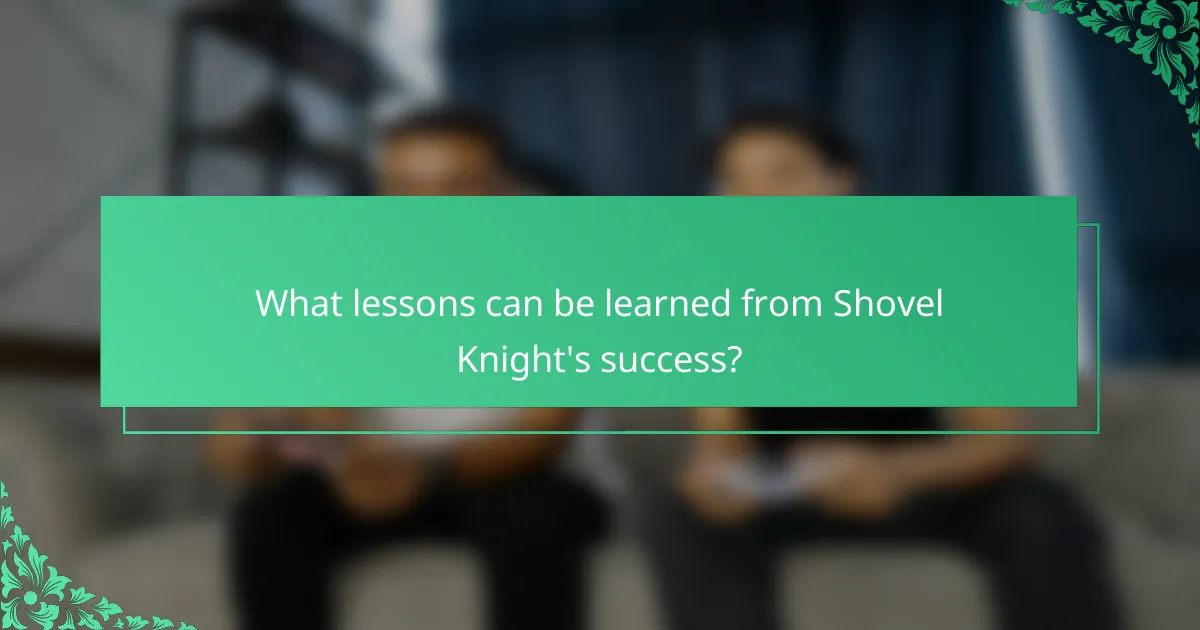
What lessons can be learned from Shovel Knight’s success?
Shovel Knight’s success teaches valuable lessons in game design and community engagement. Its blend of retro aesthetics and modern gameplay mechanics created a unique experience that resonated with players. The game’s strong narrative and character development fostered emotional connections, enhancing player investment. Additionally, the developers’ commitment to community feedback and continuous updates built a loyal fanbase, demonstrating the importance of audience interaction in achieving long-term success.
Which best practices can developers adopt from its design?
Developers can adopt several best practices from Shovel Knight’s design, focusing on gameplay mechanics, storytelling, and art style. Emphasizing tight controls enhances player engagement. Incorporating a rich narrative with character development fosters emotional investment. Utilizing pixel art evokes nostalgia while ensuring clarity in visual design. Balancing difficulty maintains challenge without frustration, promoting player satisfaction. Regular updates and community feedback can refine gameplay, ensuring longevity and relevance.
What common mistakes should be avoided in game development?
To avoid common mistakes in game development, focus on planning, user feedback, and testing. Neglecting these aspects can lead to poor gameplay experience and project delays.
1. Inadequate planning can result in scope creep and disorganization.
2. Ignoring player feedback may lead to a game that does not meet audience expectations.
3. Failing to test thoroughly can result in bugs and gameplay issues.
4. Overlooking marketing strategies can hinder the game’s visibility and success.
5. Skipping documentation can complicate future updates and team collaboration.
